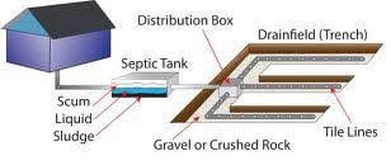Septic Systems
This is one example of the many possible septic system designs that exist

Septic System Inspection & Services
Read below for further explanation of each septic system inspection & service.
Read below for further explanation of each septic system inspection & service.
Septic System Evaluation (Inspection) - Best Practice - The goal of the Septic System Evaluation is to evaluate the size, location and condition of the system overall and its individual major components (e.g., tank(s); soil absorption system (drainfield); pumps/alarms). Through your Agent, we will initiate a request to the Seller for information (e.g., locations of system components; system & component design information; maintenance records) and also for Coordinated Pumping. In addition, a Hydraulic Load Test (HLT) may be recommended. To minimize your cost, portions of the Septic System Evaluation, Coordinated Pumping, (and HLT if recommended) are requested to occur at a specific date and time; most often this will be during your home inspection or during retrieval of the radon monitor. If this is not possible, and additional visits to the home are required to perform our work, a return visit fee is required (to be paid in advance, or if agreed, upon our arrival). We make every effort to avoid re-visits, but sometimes they are required due to the Pumping Company's schedule, the Seller's schedule, or for other reasons.
|
Coordinated Pumping - Most often per your sales contract, the cost of coordinated pumping is borne by and arranged by the Seller through the company that normally services the system - (See @line #376 of the Standard Sales Agreement). We will request Coordinated Pumping through your Agent. Any/all tanks are to be pumped in our presence so we may evaluate the system at operating level, and then view the interior of the tank(s) when they are empty and clean. Coordinated Pumping includes any excavation required to access any/all components (e.g., manways; inspection ports at the tanks and/or at the soil absorption system; distribution boxes), removal of the lids of the aforementioned items and reinstallation of same upon completion, and any/all lawn restoration. To be clear, "we do not dig or lift".
|
Hydraulic Load Test (HLT) - If the home has been unoccupied for more than 7 days, or in certain other situations, a Hydraulic Load Test is recommended to replicate operating conditions. During periods of inactivity, the soil absorption system (drainfield) can dry out and a failed soil absorption system can appear to be functional. To perform the Hydraulic Load Test, a specific volume of water (based upon the number of bedrooms in the home) is introduced into the system over each of two consecutive days. The DEP Design Daily Value (DDV) for a three-bedroom home is 400G. At the end of the 2nd day, the system is evaluated to determine whether it accepted the DDV. Our Fee is based on using the home's water system as the source of water. We will request water and tank access for the HLT through your agent. Most often per your sales contract, tank access & water for the HLT is provided by the Seller - (See @line #376 of the Standard Sales Agreement). It depends upon the septic system configuration, but for most systems, the HLT is begun several days in advance of Coordinated Pumping and access to tank(s) is required at that time.
|
Dye Test - A Dye Test is an investigative tool. The primary use of a Dye Test is to visually verify a connection between two points (e.g. whether a particular fixture is connected to the septic system or whether dye flushed down a toilet travels to the surface of the ground). Unfortunately, it can take up to several days for dye to surface, if ever, and most inspectors will not be present to see it if it does. In certain situations we recommend a Dye Test; however, a Dye Test is not a substitute for a Septic System Evaluation and it provides very little information about the system in general or its components.